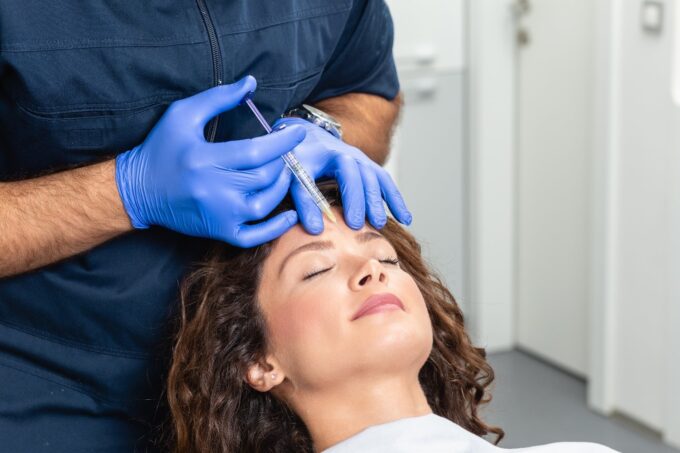When it comes to chronic migraine treatment, Dr. Richard Hatfield—a cosmetic surgeon currently studying functional medicine, with a background as a family physician—often highlights the benefits of Botox as a revolutionary therapy that offers more than just pain relief. Having owned two cosmetic minor surgery clinics, Dr. Hatfield has seen firsthand how Botox, widely known for its cosmetic applications, can also provide substantial relief to those suffering from chronic migraines. Approved by the FDA for this purpose in 2010, Botox has since become a key player in migraine management, offering benefits that extend beyond simply reducing headache pain.
How Botox Works for Migraines
Botox is widely known for its cosmetic applications, particularly in reducing wrinkles by temporarily paralyzing facial muscles. However, its application in migraine therapy operates under a different mechanism. Dr. Richard Hatfield explains that when injected into specific areas around the head and neck, Botox blocks the release of certain chemicals involved in pain transmission, preventing migraine headaches before they start. These injections are typically administered every 12 weeks, targeting multiple areas to maximize effectiveness.
The treatment regimen involves injecting Botox into 31 sites across seven key areas, including the forehead, temples, back of the head, neck, and shoulders. This comprehensive approach addresses the widespread nature of migraine pain, which often affects multiple regions simultaneously.
More Than Just Pain Relief
While the primary goal of Botox therapy for migraines is to reduce the number of headache days per month, Dr. Richard Hatfield emphasizes that patients often experience additional benefits that enhance their overall quality of life.
- Reduced Frequency and Intensity of Migraines
Patients treated with Botox report a significant decrease in the frequency of migraine attacks. For many, this reduction means going from experiencing 15 or more headache days per month to having fewer than 10. Moreover, the intensity of the migraines that do occur tends to be less severe, making them easier to manage with other treatments or lifestyle adjustments.
- Improved Daily Functioning
Chronic migraines can severely impact daily activities, including work, social interactions, and personal responsibilities. Dr. Richard Hatfield notes that patients who receive Botox therapy often find that they can return to a more normal routine, with fewer interruptions caused by migraine pain. This improvement in daily functioning is one of the most valued benefits among patients, as it allows them to engage more fully in their lives.
- Reduced Dependence on Medication
Chronic migraine sufferers often rely on a variety of medications, including pain relievers, triptans, and anti-nausea drugs, to manage their symptoms. These medications can have side effects, and overuse can lead to medication-overuse headaches, further complicating treatment. Botox therapy, as Dr. Richard Hatfield points out, reduces the need for frequent medication, helping patients avoid these pitfalls and simplifying their overall treatment plan.
- Enhanced Emotional Well-Being
The chronic nature of migraines can lead to significant emotional distress, including anxiety and depression. The unpredictability of migraine attacks often exacerbates these feelings, as sufferers may live in constant fear of their next headache. By reducing the frequency and severity of migraines, Botox helps alleviate some of this emotional burden, leading to improved mental health and a more positive outlook on life.
- Better Sleep Quality
Migraines are notorious for disrupting sleep patterns, whether through pain-induced insomnia or the aftereffects of a severe headache. Many patients treated by Dr. Richard Hatfield report that with fewer migraines, their sleep quality improves. Better sleep is crucial for overall health and can further reduce the likelihood of migraines, creating a beneficial cycle of improvement.
- A Non-Invasive, Long-Term Solution
Unlike other treatments that may require daily medication or invasive procedures, Botox offers a relatively simple and non-invasive option for long-term migraine management. Dr. Richard Hatfield highlights that the treatment’s effectiveness increases over time, with many patients experiencing more substantial relief after successive rounds of injections. This long-term solution is appealing to many, as it provides sustained benefits with minimal disruption to their lives.
Considerations and Potential Side Effects
While Botox is generally well-tolerated, Dr. Richard Hatfield advises that patients should be aware of potential side effects. These can include mild pain at the injection site, temporary muscle weakness, or, in rare cases, more serious complications such as difficulty swallowing or breathing. It’s crucial for patients to discuss their medical history and any concerns with their healthcare provider before starting treatment to ensure Botox is a safe and suitable option for them.
Another important consideration is the cost of Botox therapy. While many insurance plans cover Botox for chronic migraines, the out-of-pocket costs can still be significant for some patients. However, Dr. Richard Hatfield points out that the reduction in migraine frequency and the subsequent decrease in other healthcare costs, such as emergency room visits and medications, can make Botox a cost-effective solution in the long run.
Who is a Candidate for Botox Therapy?
Dr. Richard Hatfield typically recommends Botox for patients who suffer from chronic migraines, defined as experiencing 15 or more headache days per month, with at least eight of those days being migraines. It is particularly beneficial for those who have not found adequate relief from other migraine treatments or who cannot tolerate the side effects of traditional migraine medications.
Patients considering Botox should undergo a thorough evaluation by a healthcare professional to determine if they are suitable candidates. Factors such as the pattern of migraines, overall health, and previous treatment responses are all considered in making this decision.
Final Thoughts
Dr. Richard Hatfield’s experience with Botox for chronic migraines underscores its value as a comprehensive treatment that offers much more than just pain relief. By addressing both the physical and emotional aspects of chronic migraines, Botox therapy helps patients reclaim control over their lives, reducing the burden of this debilitating condition. For those who have struggled with the limitations imposed by frequent migraines, Botox provides a path to not only fewer headaches but also a fuller, more vibrant life.
